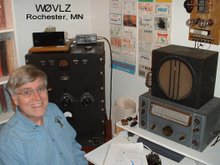Friday, December 9, 2016
More on my 20 meter Endfed Zepp
I've always been a little worried about feed line loss in my portable antenna / 20 meter Endfed Zepp.
TV twin lead does have more loss then lots of other feed lines that may be used but it is light and we're talking about less than 15 feet of the stuff here. Estimates I've found on the web show .5 - 1 dB loss per 100' for dry, clean, matched TV twin lead. The loss for 15' then comes out around .1 dB. Since my intended use of this antenna is temporary QRP-in-th-Park sort of operating, keeping the twin lead clean and dry should not be a problem. If it's raining, I just QRT, packup and go home.
Loss due to mismatch at the antenna is the other issue. See K5DVW's Nov 2006 QST article posted at http://www.arrl.org/files/file/Technology/tis/info/pdf/q1106037.pdf Assuming that the EFHW wire presents a 3000 ohm load to the 300 ohm feedline then the SWR is about 10:1. Extrapolating off the left edge of K5DVW's figure 1 chart leads me to conclude that this 10:1 feedline mismatch adds another .5 dB loss for about.6 dB total. Feedline loss for 30' of RG-58 (about the most I'd want to carry any distance) feeding a matched dipole at 14MHz is .4-.5 dB.
It appears that the feedline loss difference between 15' of twin lead feeding an EFHW wire and 30' of coax feeding a dipole is negligible.
My classic 20 meter endfed zepp antenna with quarter wavelength feed does require a tuner. While in theory the feedline could be trimmed and stubbed to present a 50 ohm load to the transmitter (see http://www.mfjenterprises.com/antennatalk8.php ) it is sensitive to antenna configuration and adjacent objects. A tuner of some sort is required to take care of the variable mismatch, but, since it is close to 50 ohms, the tuner does not need to be "wide range".
So based on my observations for this antenna -
- Some sort of tuner is required (built into many QRP rigs these days)
- Feedline loss is essentially same as coax
- Allows flexible deployment (Vee, L, vertical, sloper)
- No ground (or radial or conterpoise) requirement
- Light weight
- Entire antenna system is off the ground
- Usually requires only one support
- Optimized for one band but usually can be tuned as a random length end wire for other bands
Subscribe to:
Post Comments (Atom)

2 comments:
Where tv twinlead falls down is either really long runs, (100 ft or more) and high power, a couple hundred watts or more will literally melt it! But for short runs at lower powers, it's perfectly serviceable. I also think entirely too much fuss is being made about perfect SWR and everything having to be 50 ohms. A given antenna is maybe 50 ohms at ONE frequency, at that depends on height above ground, ground conductivity, etc.
And not every sntenns is 50ohms. In fact I would bet none of mine. Lw or the 3 verticals
Post a Comment